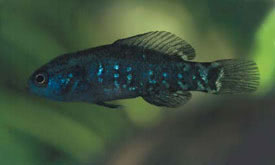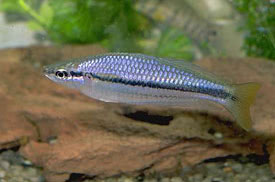
 Magyarul / Hungarian
Magyarul / Hungarian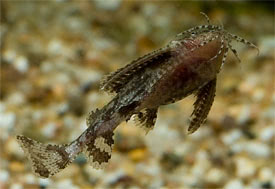
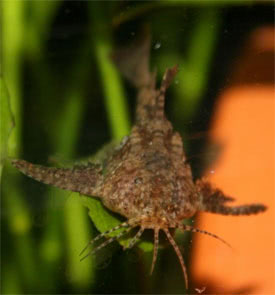

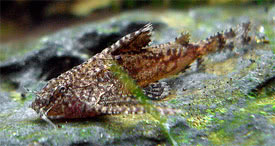
- Scientific name: Hara jerdoni
- Synonyms: Erethistes jerdoni
- Common name: Asian Stone Catfish
- Group: Catfishes
- Habitat: Asia; India, Bangladesh
- Size: 3-3,5 cm
- Biotope: Inhabits in current-rich rivers and slow-flowing creeks and streams.
- Social behavior: Peaceful and shy catfish, can be kept with other small and peaceful species in a community tank.
- Diet: Omnivorous; a noctunal feeder so feed after lights out. Will eat a variety of live and frozen foods, also accept dried foods.
- Breeding: Very hard
- Tank: Minimum 30 litres
- Population: 3-4 fish for 40 litres
- Decoration: Use fine sand as substrate, and put some dried oak or beech leaves on it. Decorate the tank with roots and build rock caves to provide hiding places. Use some grass and fern like plants. The water must be kept clean, relatively cool and well-oxygenated.
- Temperature: 18-24 °C
- pH: 5.6-7.6
- Hardness: 8-15 NK°
- Lifespan: 5 years
Description: It is more commonly called an anchor cat, due to its ‘anchor’ like shape when viewed from above. It is a small, nocturnal catfish. In nature it sleeps under or within roots, bamboo and rock structures during the day. The color of the body varies from a mottled grey color to light brown and it has a few darker blotchy areas, especially around the head. Asian stone catfish has extremely long pectoral spines and they use their strong pectoral fin spines to lodge themselves into any nooks that they can find in the river. The fish can turn shades of brown and tan to blend in with surroundings. Good water quality and high level of dissolved oxygen is essential to keep these catfish, as they don’t tolerate well nitrate levels above 12.5 mg/l. The first indication that there is something wrong with the water is that they appear to shed their skin.
Females are a little longer, and significantly fuller than the 3 cm, very slender males. This fish has been bred in the aquarium, however only a very few details are available. For breeding, try to place 4-5 adult fish in a small aquarium and decorate it with Java moss. Condition the fish with live foods for a couple of days, and after 4 days do a 30% water cahnge. If you are lucky, the fish will deposit the small eggs in the Java moss. The fry are very tiny and only eat small live foods or liquid fish food. The fry are very delicate and require plenty of time and attention.








